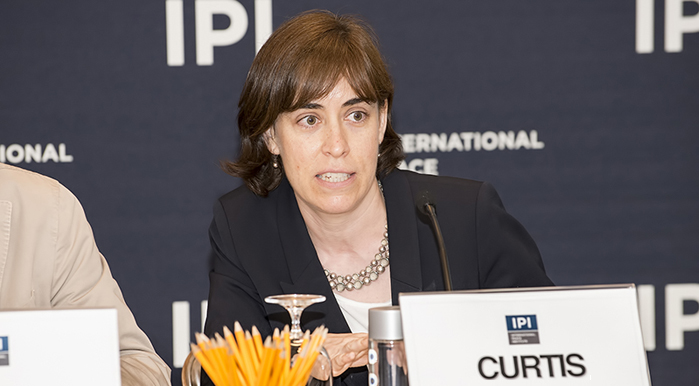
In a new volume which challenges traditional peacebuilding frameworks in Africa, seventeen chapter authors of the book Peacebuilding, Power, and Politics in Africa, examine the tensions in the interaction between local and global actors engaged in building peace on the continent. The book, a joint collaboration between Cambridge University and the Centre for Conflict Resolution in South Africa, was introduced at the International Peace Institute on July 2, 2013 by co-editor Dr. Devon Curtis.
The book considers themes of peacebuilding, the international, regional, and national institutions working to implement them and then considers country case studies including Sudan, the Great Lakes Region, Sierra Leone and Liberia, the Niger Delta, Southern African, and Somalia. Throughout the chapters, authors highlight the problematic nature of peacebuilding initiatives in both the conceptual and practical sense and consider three contrasting frameworks: peacebuilding as liberal governance, peacebuilding as stabilization, and peacebuilding as social justice.
Describing peacebuilding as a “terrain of contestation,” Ms. Curtis said that the book exposes a lot of the tensions that are at the heart of peacebuilding. “I am not sure that these tensions can be resolved. There’s no denying that conflict in Africa has enormous costs and the horrors of that violence urge us towards an imagined, shared alternative called peace,” she said, noting that the term is subjective and continually being negotiated between practitioners and theorists.
“When international programs seems to be insufficient, we look towards African institutions, but I suppose the message that this book tries to make is that peace isn’t something to be discovered and it’s not something to be imposed,” she argued, “but it’s a set of different and continually contested practices where the very meaning of peace and peacebuilding is constantly being negotiated. And masking this very subjective nature of peace, I think, disguises the ideology and relations of power that are behind it.”
Ejeviome Otobo, Director and Deputy Head of the United Nations Peacebuilding Support Office, presented as a discussant. He explained the three strands of literature on peacebuilding and considered some questions that are often raised. One was the definition and conceptional issues of peacebuilding. “This is where people ask the question, is peacebuilding the same thing as state building and nation building? If not, how are they different?” he said.
The second strand was institutions, which includes those needed for peacebuilding to succeed, for decision making, and for financing. The third strand was the action of peacebuilding in practice.
Mr. Otobo also spoke about the work of the Peacebuilding Commission and the three rules it follows: political accompaniment and advocacy, resource mobilization, and fostering coherence among the multiplicity of actors in the field. He took the example of Liberia, highlighting the Commission’s efforts of building security and justice hubs in order to decentralize state authority from Monrovia and allow the citizens to have access to justice.
Ultimately, the authors of the volume asked, can peacebuilding assumed to be a force for good? The key messages of the discussion were:
1. Debates surrounding peacebuilding have existed for centuries but the end of the Cold War brought new, distinctive areas of policy intervention and a renewed focus on the unarticulated ideology behind peace. Inevitably, there are winners and losers in post conflict countries, largely determined by the approach adopted by peacebuilders e.g. negotiations or imposed military solutions.
2. The normative frameworks can be broadly divided into three categories, the first being peacebuilding as liberal governance. In this model, multi-party democracies and free economies are desirable but encounter problems when countries emerging from conflict do not conform to these ideals.
3. Secondly, peacebuilding as stabilization encourages order, control and secure borders in order to maintain global security. Low intensity conflict is often accepted as inevitable and as long as it does not threaten international stability, increased militarization frequently characterizes the search for peace.
4. Thirdly, peacebuilding as social justice seeks to address issues of inequality. The agents of this peacebuilding methodology often dictate the beneficiaries: social justice must go beyond ownership by government and the elites in order to identify and include local groups who want to promote the politics of inclusion and representation.
5. Because of these varied philosophies, many of the authors consider peacebuilding to be a terrain of contestation in which tensions exist between and within local, regional and international actors engaged in the field. Accordingly, development agendas and their beneficiaries vary depending on the framework of peacebuilding adopted.
6. Statebuilding is not automatically a route to peace, such as in Somalia. In some circumstance, peace can be inhibited if statebuilding is prioritized.
7. All contexts of peacebuilding are different and models of success cannot necessarily be transposed onto new countries or processes. Local ownership must be combined with international support to find context specific solutions.
8. The Peacebuilding Commission (PBC) faces challenges of entry and of exit onto its agenda, as well as of financing and political support. It is possible that by this time next year one country will have “graduated” from the PBC.
Peacebuilding Isn’t Always a Force for Good: Interview with Devon Curtis
Watch event:







